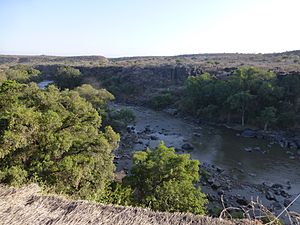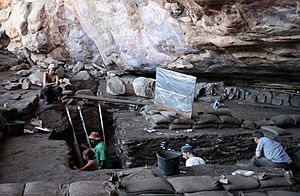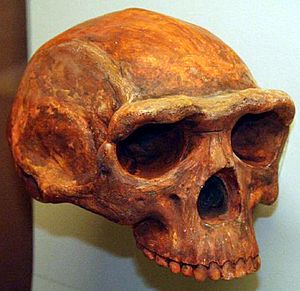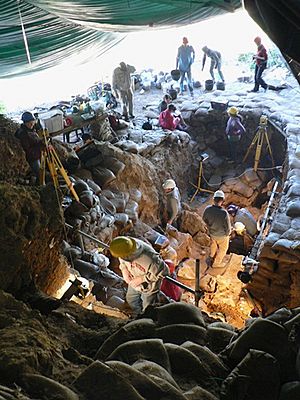Middle Stone Age facts for kids
The Middle Stone Age (or MSA) was a time in African prehistory. It came between the Early Stone Age and the Late Stone Age. This period generally started around 280,000 years ago. It ended about 50,000 to 25,000 years ago. Some experts think it began even earlier, around 550,000 to 500,000 years ago. This is because some MSA stone tools appeared then.
The MSA is sometimes confused with the Middle Paleolithic in Europe. They happened at similar times. However, the Middle Paleolithic in Europe involved Neanderthals. The MSA in Africa was home to early modern humans. Research shows that modern human ways of thinking and behaving started earlier in Africa. This happened during the MSA. The MSA is linked to both modern humans (Homo sapiens) and older types of Homo sapiens. Early signs of this period are found in Ethiopia, Kenya, and South Africa.
Contents
Where the Middle Stone Age Developed
Archaeological sites from the Middle Stone Age are found all over Africa. Experts usually divide these sites into five main areas:
- Northern Africa (Morocco, Algeria, Tunisia, Libya)
- Eastern Africa (Ethiopia to southern Kenya)
- Central Africa (Tanzania, Kenya, and Angola)
- Southern Africa (many cave sites in South Africa)
- Western Africa
In northern and western Africa, the Sahara desert's wet and dry periods affected sites. This shows how early humans adapted to changing climates.
Eastern Africa has some of the oldest MSA sites. Dates from this region are very reliable. This is because scientists use radiocarbon dating on volcanic ash. Animal remains are not always well-preserved here. Changes in stone tool technology were less sudden in this region. This might be due to better climate conditions. These conditions allowed people to live in places for longer. Central Africa shows similar patterns to eastern Africa. More archaeological study is still needed there.
Southern Africa has many cave sites. These sites show clear changes in stone tool technology. Research in this area has been steady and well-organized. This allows for good comparisons between sites. Much of the evidence for modern human behavior comes from this region. Important sites include Blombos Cave, Howiesons Poort, Still Bay, and Pinnacle Point.
How Tools Changed from the Early Stone Age
The term "Middle Stone Age" (MSA) was first suggested in 1929. It described a period that followed the Acheulean period. The Acheulean period was known for large handaxes. The MSA began with a transition period called the Fauresmith industry. This period started around 511,000 to 435,000 years ago. This marks the start of the MSA, not the end of the Acheulean period.
The MSA is linked to the slow replacement of older human types by modern humans. Some experts define MSA sites by the use of the Levallois technique. This method made flakes for tools. The "early MSA" (EMSA) refers to sites older than 126,000 years ago. The "later MSA" (LMSA) refers to sites younger than 126,000 years ago.
In this view, the MSA starts after about 280,000 years ago. It is mostly linked with H. sapiens. The earliest well-dated MSA site in East Africa is Gademotta in Ethiopia. It dates to 276,000 years ago. The Middle Awash valley in Ethiopia and the Central Rift Valley in Kenya were important areas. New behaviors and tools likely developed there. Many large animals lived in these regions. This supported many human groups. Their ways of getting food and making things were similar to modern hunter-gatherers.
Archaeological finds in eastern Africa show the shift from Acheulean to MSA tools. Acheulean tools, like handaxes, are found below or mixed with MSA tools. MSA tools include Levallois tools, flakes, and smaller pointed tools. Sometimes, tools with handles were found. This layering shows that MSA tools slowly replaced Acheulean ones. The earliest MSA tools are at Gademotta. The latest Acheulean tools are at the Bouri Formation in Ethiopia. This suggests the two tool types might have been used at the same time for 100,000 to 150,000 years.
Late Acheulean tools linked to Homo sapiens have been found in South African caves. Sites like the Cave of Hearths and Montague Cave have both Acheulean and later MSA tools. However, there is no clear evidence of them being used together in this region.
Acheulean sites are common in West Africa. Most of them are not dated. Some late Acheulean sites have been dated. Middle Pleistocene sites (before 126,000 years ago) are in the northern Sahelian zones. Late Pleistocene sites (after 126,000 years ago) are in both northern and southern West Africa. Unlike other parts of Africa, MSA sites in West Africa seem to have lasted much longer. They continued until about 12,000 years ago. This might mean that older human types survived longer there. They may have also mixed with H. sapiens later in West Africa. These findings show that human cultures varied greatly across time and space in Africa.
Stone Tool Technology
Early blades, which are long, thin stone tools, appeared very early. They date back 550,000 to 500,000 years ago. These were found in Kenya and South Africa. Tools with a blunted back edge, called backed pieces, were found in Zambia. They date to between 300,000 and 140,000 years ago. These tools show new behaviors. The blades from Kenya, dating to about 280,000 years ago, also show high skill.
Stone tool technology during the Middle Stone Age used many different methods. Around 300,000 years ago, the large cutting tools of the Acheulean period slowly disappeared. They were replaced by Levallois prepared core tools. Neanderthals also used these tools in Europe. As the MSA continued, many different tool types became common in Africa. These included pointed tools, blades, and scrapers. Grinding stones and even bone tools were also used.
Blades, often linked with the Upper Palaeolithic in Europe, were also used at many MSA sites in Africa. They might have been used from the transition from the Early Stone Age onwards. Later in the Middle Stone Age, very small tools called microliths appeared. These were used as parts of larger tools with handles. They are seen from at least 70,000 years ago at sites like Pinnacle Point and Diepkloof Rock Shelter in South Africa.
Tool technology in the Middle Stone Age showed a pattern. New ideas appeared, then disappeared, and then sometimes came back. This happened with things like shell beads, arrows, and tools for working animal hides. It also happened with gluing technology. This suggests that human progress was not always a steady climb. Instead, it might have been driven more by changes in the environment than by changes in human thinking.
Human Evolution and Movement
Humans moved out of Africa twice. The first time, Homo erectus spread into Asia and Europe. This happened about 1.9 to 1.7 million years ago. The second time, Homo sapiens began to leave Africa during the MSA. This started around 80,000 to 50,000 years ago. They moved to Asia, Australia, and Europe. At first, there might have been only small groups. But by 30,000 years ago, they had replaced Neanderthals and Homo erectus. These movements show how flexible humans were. They could survive in many different climates.
Studies of human skulls suggest that Homo sapiens first appeared in central or southern Africa. This area shows the most variety in human features. Genetic evidence also supports this idea. However, some genetic evidence suggests that humans started spreading out of Africa from eastern Africa. Fossil evidence from sites like Omo Kibish, Herto, and Mumba Cave also supports this.
Signs of Modern Human Behavior
Many ideas exist about how modern human behavior developed. Today, most experts favor the "mosaic approach." This means that different modern behaviors appeared at different times. Some scholars, like Richard G. Klein, believe there was a sudden change. Others, like McBrearty and Brooks, argue that signs of advanced thinking can be seen earlier in the MSA. They link the origin of our species to the start of MSA technology around 250,000 to 300,000 years ago.
The oldest remains of Homo sapiens are about 300,000 years old in Africa. The continent was mostly home to hunter-gatherer groups. In both eastern and southern Africa, there is a lot of variety at Homo sapiens sites. It was during this time that we see signs of modern human behavior. According to McBrearty and Brooks, modern human behavior has four main features:
- Abstract thinking (thinking about things that are not real or present)
- The ability to plan and strategize
- Being innovative in behavior, economy, and technology
- Symbolic behavior (using symbols)
Many of these ideas can be broken down further. They include art, personal decoration, and new technologies. These four main categories help us discuss how modern behavior developed.
Cultural Groups and Styles
As early Homo sapiens moved into different environments during the MSA, their archaeological record changed. It began to show regional differences. These differences are important. They show that Homo sapiens could adapt to many environments. These included coastal areas, grasslands, deserts, and forests. This ability to adapt is seen in MSA artifacts. These artifacts show different styles depending on the region.
During the Acheulean period (1.5 million to 300,000 years ago), stone tools looked very similar everywhere. MSA technologies, with their regional differences, show a big step forward. This information supports ideas about social and stylistic development during the MSA.
In southern Africa, we see tool groups called Howiesons Poort and Stillbay. They are named after the places where they were first found. Other groups, like the Lupemban in central Africa and the Aterian in northern Africa, also existed.
Abstract Thinking
Signs of abstract thinking appear as early as 300,000 to 250,000 years ago. This was during the shift from Acheulean to Middle Stone Age tools. This change involved moving from large Acheulean tools to smaller blades and microliths. Making these new tools needed planning. It also required understanding how hitting a stone would create different flakes. This kind of thinking is abstract. It is a key sign of modern human behavior. The shift to smaller, more varied tools in the MSA shows a better understanding of how to make stone tools. It also shows an understanding of what different tools could be used for.
Planning Ahead
The ability to plan and strategize is seen in the varied tools of the Middle Stone Age. It is also clear in how people found food. As MSA humans moved into different environments, they had to plan their hunting. They needed to find food based on what was available each season. Evidence of knowing about seasons comes from animal remains at temporary sites. In harsh environments, this knowledge was vital for survival. Planning food strategies based on this knowledge shows an ability to think about the future.
This planning is also seen in the presence of unusual raw materials at MSA sites. Getting local materials was easy. But MSA sites often have materials from over 100 km away. Sometimes, they came from more than 300 km away. Getting materials from such distances needed awareness of the resources. It also needed a belief that these materials were valuable. This value could be for practical use or for symbolic reasons. It might also suggest that people had exchange networks to get these materials.
New Ideas and Inventions
The ability to move into new environments across Africa and the world shows great adaptability. This adaptability is a sign of modern human behavior. Middle Stone Age sites are found in many different places. These include coastal areas, inland parts of southern and eastern Africa. In one case, MSA foragers even lived in high-altitude, cold environments in Ethiopia.
This is not the only sign of new ideas in early Homo sapiens. New, local tools were developed. For example, tools for collecting seafood were found in Ethiopia and South Africa. The use of fire also shows innovation. Fire was used to make stronger tools. For instance, heated silcrete stone was found at Blombos, Howiesons Poort, and Still Bay. Heat-treated bone tools were also found at Still Bay.
Tools with handles also show human innovation. The large cutting tools of the Acheulean period became smaller. More complex tools were better suited for diverse environments. Tools made of several parts show a new level of innovation. They were more effective and harder to make. The ability to think beyond simple stone shaping shows flexible thinking. The use of glue, often mixed with ochre, to attach flakes to handles shows an understanding of chemistry. Adhesives were used to make tools with handles by 70,000 years ago in South Africa.
Other new technologies from this time include special hunting weapons. Bone and stone arrowheads were found at South African sites like Sibudu Cave. These date to about 60,000 to 70,000 years ago. An early bone needle was also found at Sibudu. Bone harpoons were found in Central Africa, dating to about 90,000 years ago. There is also evidence of heating silcrete stone to make it easier to flake for tools. This started around 164,000 years ago in South Africa. It became common there for making microlithic tools around 72,000 years ago.
Modern human behaviors are seen at Panga ya Saidi in Kenya. These include making shell beads, bone tools, and arrows. The use of ochre pigment is also evident. These date to 78,000 to 67,000 years ago. Early stone-tipped projectile weapons, like javelin tips, were found in Ethiopia. They date to around 279,000 years ago.
In 2018, evidence from a site in Kenya, Olorgesailie, showed early innovations. These date to about 320,000 years ago. They include long-distance trade networks for things like obsidian. The use of pigments and possible making of projectile points were also found. These behaviors are from around the same time as the oldest known Homo sapiens fossils in Africa. This suggests that complex behaviors had already started when Homo sapiens first appeared.
Symbolic Behavior
Symbolic behavior is hard to find in the archaeological record. When looking for it in the MSA, we consider three types of evidence:
- Direct evidence: actual examples of symbols.
- Indirect evidence: behaviors that show symbolic thought.
- Technological evidence: tools and skills used to make art.
Direct evidence is rare before 40,000 years ago. Indirect evidence is hard to prove. So, technological evidence is often the most useful.
Today, many archaeologists agree that the world's first art and symbolic culture came from the African Middle Stone Age. Some amazing artifacts are engraved pieces of red ochre. These were made at Blombos Cave in South Africa 75,000 years ago. Pierced and ochre-stained Nassarius shell beads were also found at Blombos. Even older examples were found at the Taforalt Caves.
Also, ostrich eggshell containers with geometric designs were found at Diepkloof, South Africa. These date to 60,000 years ago. Beads and other personal decorations were found in Morocco. They might be as old as 130,000 years. The Cave of Hearths in South Africa has beads from much earlier than 50,000 years ago. At Panga ya Saidi in Kenya, marine shell beads appear as early as 67,000 years ago. Engraved ochre is found there by 48,500 years ago. Arrows and tools for working hides (including a needle-like tool) were found at Sibudu Cave. These date to about 70,000 to 60,000 years ago. They show that people made weapons using complex heat-treated glue. Evidence for making paints using a complex process also exists. This dates to 100,000 years ago in South Africa. The use of pigments in Kenya dates to about 320,000 years ago.
Complex Thinking Skills
A series of new ideas were found at Pinnacle Point 13B in South Africa. These date to 170,000 to 160,000 years ago. This includes the oldest confirmed use of ochre and seafood for food. Based on animal bones at Klasies, MSA people were skilled hunters. Their social behavior was similar to modern humans.
Some experts believe that managing plant food resources shows modern human behavior. This was done by burning the land to help plants with corms or tubers grow. This happened in South Africa during the Howiesons Poort period (around 70,000-55,000 years ago). Other signs of modernity include family-based foraging groups, color symbolism, and sharing artifacts. Also, the organized layout of living spaces points to modern behavior.
Researchers like Lyn Wadley argue that making complex glue for spears needed advanced skills. This glue was made from gum and red ochre. This suggests that humans 70,000 years ago at Sibudu Cave had similar thinking abilities to modern humans.
In 2008, an ochre processing workshop was found at Blombos Cave. It dates to about 100,000 years ago. It was likely used to make paints. Analysis shows that a liquid pigment mix was made and stored in abalone shells. Ochre, bone, charcoal, grinding stones, and hammer-stones were part of the toolkits. The complexity of this task shows advanced thinking. People had to gather materials from different places. They likely used heat to get fat from bone. They followed a recipe to make the mixture. They also used shells for mixing and storing for later use.
Evidence for Language
Ochre is found at some early MSA sites. It is common after about 100,000 years ago. Some experts argue that if ochre was used for symbolic reasons, like color, then language must have existed. They suggest ochre could be a sign of language appearing.
Formal bone tools are often linked to modern behavior by archaeologists. Sophisticated bone harpoons from Katanda, West Africa, date to about 90,000 years ago. Bone tools from Blombos Cave date to about 77,000 years ago. These could be examples of tools linked to modern language.
Language is thought to be needed to keep exchange networks going. Evidence of exchange networks during the Middle Stone Age exists. Stone tools were found far from their original raw material sources. At five MSA sites, tools were found 140 to 340 km from their source. This suggests that exchange networks made these distances possible. Some experts also believe that complex language allowed MSA people to live in the tropical forests of the Democratic Republic of the Congo.
Many experts think that the development of complex language was key to this "symbolic explosion." Language would have allowed for endless conversations. Its full adoption might have been a crucial part of modern symbolic behavior in the MSA.
Brain Changes
It is hard to directly link changes in brain structure to the appearance of modern human bodies. However, it is likely that human brains changed through the same natural selection processes as other body parts. Genes that helped with symbolic thinking might have been chosen. This suggests that the basis for symbolic culture might be rooted in biology. But symbolic behavior itself might have appeared later, even if the brain capacity was there earlier.
Some researchers argue that the human brain grew, especially the prefrontal cortex. This made the brain able to symbolize things that were not symbolic before. This process was slow at first but sped up in the last 100,000 years. Symbolic behavior could then help this process. It would lead to a greater ability to make symbolic artifacts and social networks. According to the research team at Jebel Irhoud, Homo sapiens were the ones who left behind Middle Stone Age tools across Africa.
Important Sites
Many sites in southern Africa show the four signs of modern human behavior. Blombos Cave, South Africa, has personal ornaments. It also has tools believed to be used for making art, as well as bone tools. Still Bay and Howieson's Poort have different tool technologies. These different tool sets help researchers guess what behaviors were linked to them. For example, changes in how people found food are supported by animal bone data at these sites.
- Blombos Cave, South Africa
- Klasies River Caves, South Africa
- Sibudu Cave, South Africa
- Diepkloof Rock Shelter, South Africa
- Pinnacle Point, South Africa
- Border Cave, South Africa
- Bambata Cave, South Africa
- Mossel Bay, South Africa
- Mumba Cave, Tanzania
- Mumbwa Caves, Zambia
- Laminia and Saxomununya, Senegal
Images for kids
See also
 In Spanish: Edad de Piedra Media para niños
In Spanish: Edad de Piedra Media para niños








